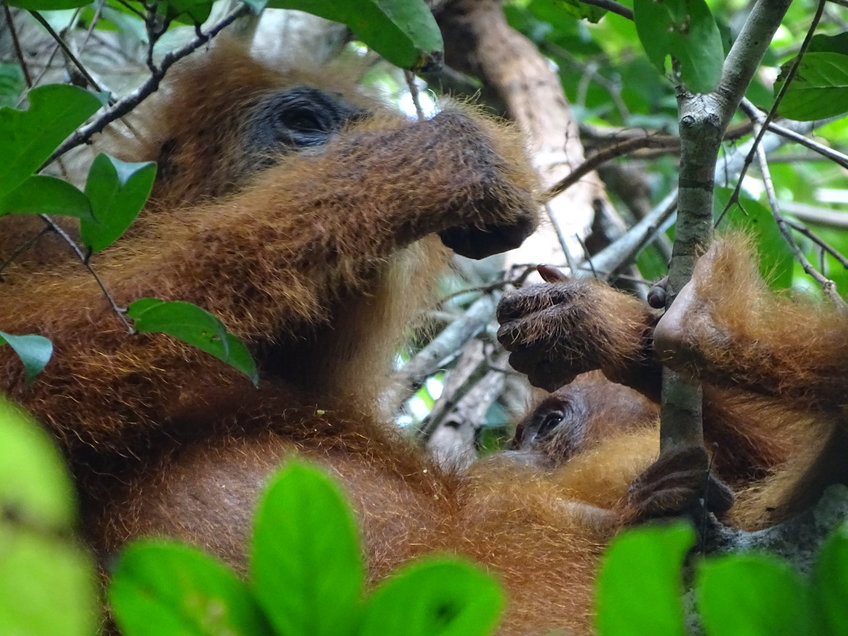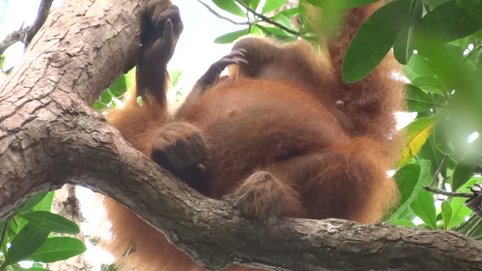Orangutan mothers help offspring to learn
A new study demonstrates for the first time that orangutan mothers are actively involved in their offspring’s skill learning
When it comes to motherhood, orangutans are animals of distinction. An orangutan mother will stay in close contact with her baby for up to nine years—longer than almost all mammals other than humans. Much like humans, orangutans rely on their mothers to learn life skills—such as what to eat and where to find it—before they finally reach independence almost a decade after birth. But unlike humans, orangutan mothers were not known to participate in their offspring’s learning; behaving as passive role models rather than active teachers. That is, until a team of researchers at the Max Planck Institute of Animal Behavior in Konstanz, Germany, uncovered the first evidence yet of active involvement by orangutan mothers in their offspring’s skill learning. When orangutan mothers are foraging, they tailor their behavior to match the age and abilities of their offspring, thereby helping their young to socially learn new skills. The study raises the possibility that orangutans perform teaching—a behavior that’s rare among animals—and sheds light on the factors that led to the evolution of teaching in humans.

The team studied how immature orangutans learn foraging skills. During the eight to nine year weaning period — one of the longest periods of nutritional dependency in any mammal—immatures must learn how to recognize and process more than 200 food items, many of which require several steps before they can be eaten. Easy-to-eat flowers and leaves require no processing, for example, whereas bark must be loosened from the tree and scraped with the teeth to remove the nutritional parts. The most difficult foods require tools, such as sticks that are converted into brushes for excavating honey from bee hives.
How they learn such complex foraging skills, according to previous studies, is by watching their mothers. Immatures will watch or “peer” at their mother when she is eating, especially when the food is hard to process. They will also beg or “solicit” food that the mother is eating, usually by attempting to grab the item out of her hands. But a mystery remained: why was the learning process one sided?
“It was puzzling that mothers always seemed so passive during these feeding interactions,” says Caroline Schuppli, from the Max Planck Institute of Animal Behavior, who led the study. “Mothers have so much time with their offspring, and maintain such a close connection, but they never appeared to be actively involved in the skill acquisition of their young.” The mystery was compounded by a lack of data. “Past studies had always examined skill learning from the point of view of the offspring,” says Schuppli, “so we didn’t know the role of the role model.”
Data on the mother's role
For this study, Schuppli teamed up with researchers from the University of Zurich in Switzerland, the Universitas Nasional in Indonesia, and the Max Planck Institute for Evolutionary Anthropology in Germany to gather data on the mother’s role in offspring skill development. They analyzed data on 1300 instances of begging, or “food solicitation”, by 27 immature Sumatran orangutans that were collected over twelve years at the Suaq Balimbing research area in Sumatra, Indonesia. For each event they scored if the mother would let the immature take the food or not, and then analyzed this with information on the age of the begging individual and the properties of the food item.
Results showed that orangutan mothers do respond to their offspring during feeding, and therefore facilitate learning opportunities: when their offspring solicit food, orangutan mothers adjust their tolerance according to their offspring’s age (i.e., competence levels) and according to how difficult the food item is to process. Mothers show the highest tolerance levels during the age at which their offspring acquire their food recognition and food processing skills. Furthermore, they show the highest levels of tolerance for items that are difficult to process, and they stay tolerant longest for these items. For items that require tool use, for example, the mothers show the highest tolerance levels and stay tolerant throughout the dependency period of their offspring. For leaves which can just be picked and ingested whole, they show overall lower levels of tolerance and stop sharing them when the offspring has reached a certain age.
Active involvement
Says Schuppli: “Our findings suggest that orangutan mothers are actively involved in their offspring’s skill learning. However, they do this in a reactive, rather than proactive way. Interestingly, there were very few incidents of active food sharing only. This means that orangutan immatures need to take the initiative during learning. This is very different from humans, where active teaching plays an important role and role models are much more proactive. It is also different from chimpanzees, where mothers seem to be more proactive.”
However, whether or not these behavioral adjustments by orangutan mothers classify as functional teaching is still unknown. While the study’s results match some criteria of the teaching definition, other criteria cannot be tested with the data set. “These findings give us a special insight into the factors that lead to the evolution of teaching,” says Schuppli. “While teaching is quite rare in the animal kingdom, it occurs in widely separated species. Our study shows that these orangutans have at least some, and perhaps all, of the cognitive, ecological, and social conditions to support teaching ability.”













